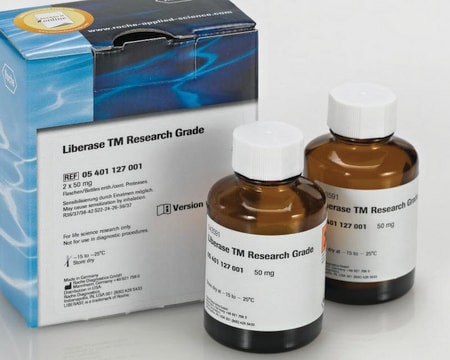G9779
Gey′s Balanced Salt Solution
liquid, sterile-filtered, suitable for cell culture
Sinonimo/i:
GBSS
Autenticatiper visualizzare i prezzi riservati alla tua organizzazione & contrattuali
About This Item
Codice UNSPSC:
12352207
NACRES:
NA.75
Prodotti consigliati
Sterilità
sterile-filtered
Forma fisica
liquid
tecniche
cell culture | mammalian: suitable
Impurezze
endotoxin, tested
Componenti
glucose: 1.0 g/L
phenol red: no
NaHCO3: 2.27 g/L
Condizioni di spedizione
ambient
Temperatura di conservazione
2-8°C
Descrizione generale
Gey′s Balanced Salt Solution is a phosphate bicarbonate buffered cell suspension and washing solution. A complete balanced salt solution with a unique combination of ""salt forms"". Contains the same five basic ions as EBSS, HBSS and DPBS.
Applicazioni
Gey′s Balanced Salt Solution has been used in:
- organotypic mouse brain slice culture
- isolation of primary murine liver sinusoidal endothelial cells (LSECs)
- organotypic hippocampal slice cultures
Codice della classe di stoccaggio
12 - Non Combustible Liquids
Classe di pericolosità dell'acqua (WGK)
nwg
Punto d’infiammabilità (°F)
Not applicable
Punto d’infiammabilità (°C)
Not applicable
Certificati d'analisi (COA)
Cerca il Certificati d'analisi (COA) digitando il numero di lotto/batch corrispondente. I numeri di lotto o di batch sono stampati sull'etichetta dei prodotti dopo la parola ‘Lotto’ o ‘Batch’.
Possiedi già questo prodotto?
I documenti relativi ai prodotti acquistati recentemente sono disponibili nell’Archivio dei documenti.
I clienti hanno visto anche
Victor Olsavszky et al.
Gene, 768, 145284-145284 (2020-11-02)
The Class H scavenger receptors Stabilin-1 (Stab1) and Stabilin-2 (Stab2) are two of the most highly expressed genes in liver sinusoidal endothelial cells (LSECs). While Stab1-deficient (Stab1KO) and Stab2-deficient (Stab2KO) mice are phenotypically unremarkable, Stab1/2-double-deficient (StabDKO) mice exhibit perisinusoidal liver
Tim C Chang et al.
Lab on a chip, 14(23), 4540-4551 (2014-10-03)
There is a critical unmet need to tailor chemotherapies to individual patients. Personalized approaches could lower treatment toxicity, improve the patient's quality of life, and ultimately reduce mortality. However, existing models of drug activity (based on tumor cells in culture
Pei-Hsuan Wu et al.
Nature genetics, 52(7), 728-739 (2020-07-01)
Pachytene PIWI-interacting RNAs (piRNAs), which comprise >80% of small RNAs in the adult mouse testis, have been proposed to bind and regulate target RNAs like microRNAs, cleave targets like short interfering RNAs or lack biological function altogether. Although piRNA pathway
Dan Xu et al.
The Journal of experimental medicine, 215(4), 1169-1186 (2018-03-01)
The pathophysiology of drug-resistant pediatric epilepsy is unknown. Flow cytometric analysis of inflammatory leukocytes in resected brain tissues from 29 pediatric patients with genetic (focal cortical dysplasia) or acquired (encephalomalacia) epilepsy demonstrated significant brain infiltration of blood-borne inflammatory myeloid cells
Soichiro Yamanaka et al.
Developmental cell, 51(1), 21-34 (2019-09-03)
Facultative heterochromatin forms and reorganizes in response to external stimuli. However, how the initial establishment of such a chromatin state is regulated in cell-cycle-arrested cells remains unexplored. Mouse gonocytes are arrested male germ cells, at which stage the genome-wide DNA
Il team dei nostri ricercatori vanta grande esperienza in tutte le aree della ricerca quali Life Science, scienza dei materiali, sintesi chimica, cromatografia, discipline analitiche, ecc..
Contatta l'Assistenza Tecnica.













